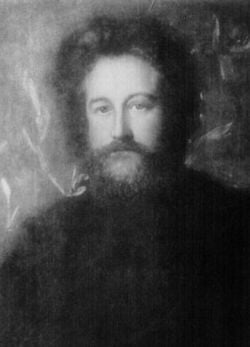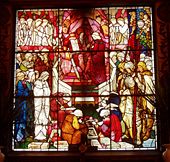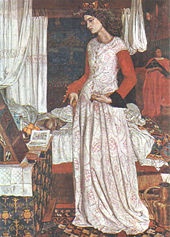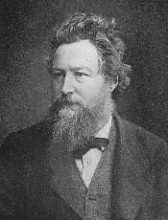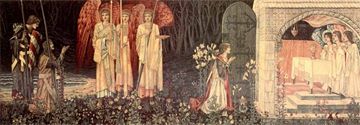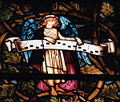William Morris
William Morris (March 24, 1834 – October 3, 1896) was an English artist, writer, socialist and activist. He was one of the principal founders of the British Arts and Crafts movement, best known as a designer of wallpaper and patterned fabrics, a writer of poetry and fiction and a pioneer of the socialist movement in Britain.
His family was wealthy, and he went to school at Marlborough College, but left in 1851 after a student rebellion there. He then went to Oxford University (Exeter College) after studying for his matriculation to the university. He became influenced by John Ruskin there, and met his life-long friends and collaborators, Dante Gabriel Rossetti, Edward Burne-Jones, Ford Madox Brown and Philip Webb there as well. He also met his wife, Jane Burden, a working-class woman whose pale skin, languid figure, and wavy, abundant dark hair were considered by Morris and his friends the epitome of beauty.
These friends formed an artistic movement, the Pre-Raphaelite Brotherhood. They eschewed the tawdry industrial manufacture of decorative arts and architecture and favoured a return to hand-craftsmanship, raising artisans to the status of artists. He espoused the philosophy that art should be affordable, hand-made, and that there should be no hierarchy of artistic mediums.
Morris had two daughters, Jane (called Jenny) and Mary (called May).
Business career
Morris left Oxford to join an architecture firm, but soon found himself drawn more and more to the decorative arts. He and Webb built Red House at Bexleyheath in Kent, Morris's wedding gift to Jane. It was here his design ideas began to take physical shape. (In honour of Morris's connection with Bexleyheath, a bust of Morris was added to an original niche in the brick clocktower in the town centre in 1996.) He also built Standen House in Sussex along with Webb.
In 1861, he founded the firm of Morris, Marshall, Faulkner & Co. with Gabriel Rossetti, Burne-Jones, Madox Brown and Philip Webb. Throughout his life, he continued to work in his own firm, although the firm changed names. Its most famous incarnation was as Morris and Company. The company encouraged the revival of traditional crafts such as stained glass painting, and Morris himself single-handedly recreated the art of tapestry weaving in England. His designs are still sold today under licences given to Sanderson and Sons and Liberty of London.
Poetry
Morris had already begun publishing poetry and short stories through a magazine founded with his friends while at university. His first independently published work, The Defence of Guenevere was coolly received by the critics, and he was discouraged from publishing more for a number of years. He had also made a painting of King Arthur's Queen Consort. However, "The Haystack in the Floods", probably these days his best-known poem, dates from just after this time. It is a grimly realistic piece set during the Hundred Years War in which the doomed lovers Jehane and Robert have a last parting in a convincingly portrayed rain-swept countryside.
When he returned to poetry it was with The Earthly Paradise, a huge collection of poems loosely bound together with the theme of a group of medieval wanderers who set out to search for a land of everlasting life and after much disillusion discover a surviving colony of Greeks with whom they exchange stories. The collection brought him almost immediate fame and popularity.
The last-written stories in the collection are retellings of Icelandic sagas, and from then until his Socialist period Morris's fascination with the ancient Germanic and Norse peoples dominated his writing. Together with his Icelandic friend Eirikr Magnusson he was the first to translate many of the Icelandic sagas into English, and his own epic retelling of the story of Sigurd the Volsung was his favourite among his poems.
Due to his wide poetic acclaim, Morris was offered the Poet Laureateship, after the death of Tennyson in 1892, but declined.
Architecture
Although Morris never became a practising architect, his interest in architecture continued throughout his life. In 1877, he founded the Society for the Protection of Ancient Buildings. His preservation work resulted indirectly in the founding of the National Trust. Combined with the inspiration of John Ruskin — in particular his work in The Stones of Venice on The Nature of Gothic — architecture played an important symbolic part in Morris's approach to socialism.
Socialism
Morris and his daughter May were amongst Britain's first socialists, working directly with Eleanor Marx and Engels to begin the socialist movement. In 1883, he joined the Social Democratic Federation, and in 1884 he organised the breakaway Socialist League. Morris found himself rather awkwardly positioned as a mediator between the Marxist and anarchist sides of the socialist movement, and bickering between the two sides eventually tore the Socialist League apart. This side of Morris's work is well-discussed in the biography (subtitled 'Romantic to Revolutionary') by E. P. Thompson. It was during this period that Morris wrote his best-known prose works; in particular A Dream of John Ball and the utopian News from Nowhere.
Morris and Rossetti rented a country house, Kelmscott Manor at Kelmscott, Oxfordshire, as a summer retreat, but it soon became a retreat for Rossetti and Jane Morris to have a long-lasting affair. After his departure from the Socialist League Morris divided his time between the Company, now relocated to Merton Abbey, the Kelmscott Press, and Kelmscott Manor, where he wrote a series of fantasy novels later to be a strong influence on J. R. R. Tolkien and C. S. Lewis. At his death in 1896 he was interred in the Kelmscott village churchyard.
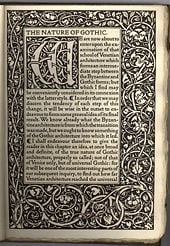
The Kelmscott Press
In January 1891, Morris founded the Kelmscott Press at Hammersmith, London, in order to produce examples of improved printing and book design. The books were designed to make reference to the methods and techniques he used, what he saw as traditional methods of printing and craftsmanship, in line with the Arts and Crafts movement as a whole, and in response to the prevalance of lithography, particularly those lithographic prints designed to look like woodcut prints. He designed clear typefaces, such as his Roman 'golden' type, which was inspired by that of the early Venetian printer Nicolaus Jenson, and medievalizing decorative borders for books that drew their inspiration from the incunabula of the 15th century and their woodcut illustrations. Selection of paper and ink, and concerns for the overall integration of type and decorations on the page made the Kelmscott Press the most famous of the private presses of the Arts and Crafts movement. It operated until 1898, producing 53 volumes, and inspired other private presses, notably the Doves Press.
Among book lovers, the Kelmscott Press edition of The Works of Geoffrey Chaucer, illustrated by Burne-Jones, is considered one of the most beautiful books ever produced. A fine edition facsimile of the Kelmscott Chaucer was published in 2002 by The Folio Society.
Morris today
The Morris Societies in Britain, the US, and Canada are active in preserving Morris's work and ideas.
The influence of William Morris lives on in modern interiors and architecture. Companies such as Harvest House and Stickley Furniture continue to sell Arts and Crafts-style pieces.
Literary works
- The Defence of Guenevere, and other Poems (1858)
- The Life and Death of Jason (1867)
- The Earthly Paradise (1868–1870)
- Love is Enough, or The Freeing of Pharamond: A Morality (1872)
- The Story of Sigurd the Volsung and the Fall of the Nibelungs (1877)
- Hopes and Fears For Art (1882)
- A Dream of John Ball (1888)
- The House of the Wolfings (1889)
- The Roots of the Mountains (1890)
- News from Nowhere (1891)
- The Story of the Glittering Plain (1891)
- The Wood Beyond the World (1894)
- Child Christopher and Goldilind the Fair (1895)
- The Well at the World's End (1896)
- The Water of the Wondrous Isles (1897)
- The Sundering Flood (1898)
Gallery
Notes
- Morris also translated large numbers of mediaeval and classical works, including collections of Icelandic sagas such as Three Northern Love Stories (1875), Virgil's Aeneid (1875), and Homer's Odyssey (1887).
- Morris's book, The Wood Beyond the World, is considered to have heavily influenced C. S. Lewis' Narnia series, while J. R. R. Tolkien was inspired by Morris's reconstructions of early Germanic life in The House of the Wolfings and The Roots of the Mountains.
- Editor and fantasy scholar Lin Carter credits Morris with originating the imaginary-world fantasy with The Well at the World's End and his subsequent fantasy novels. These contain no reference to this world; they are set neither in the past nor in the future (as is News from Nowhere), and not on another planet.
ReferencesISBN links support NWE through referral fees
See also
- Arts and Crafts movement
- Eco-socialism
- Pre-Raphaelite Brotherhood
- Victorian decorative arts
- Social Democratic Federation
- Socialism
- Socialist League
External links
- The Online Books Page e-texts of works by William Morris
- William Morris and his Circle
- William Morris Stained Glass
- The William Morris Gallery (London Borough of Waltham Forest)
- The William Morris Internet Archive (marxists.org)
- The William Morris Society
- William Morris Tiles and Textiles
- Works by William Morris. Project Gutenberg
- William Morris Exhibition
Credits
New World Encyclopedia writers and editors rewrote and completed the Wikipedia article in accordance with New World Encyclopedia standards. This article abides by terms of the Creative Commons CC-by-sa 3.0 License (CC-by-sa), which may be used and disseminated with proper attribution. Credit is due under the terms of this license that can reference both the New World Encyclopedia contributors and the selfless volunteer contributors of the Wikimedia Foundation. To cite this article click here for a list of acceptable citing formats.The history of earlier contributions by wikipedians is accessible to researchers here:
The history of this article since it was imported to New World Encyclopedia:
Note: Some restrictions may apply to use of individual images which are separately licensed.
